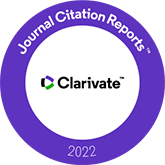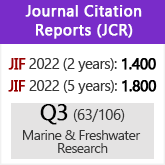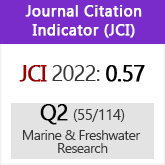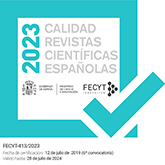Spatial distribution patterns and population structure of the sea urchin Paracentrotus lividus (Echinodermata: Echinoidea), in the coastal fishery of western Sardinia: a geostatistical analysis
DOI:
https://doi.org/10.3989/scimar.03602.26BKeywords:
Paracentrotus lividus, spatial distribution, geostatistics, biomass estimation, management, Western MediterraneanAbstract
The identification of appropriate spatial distribution patterns for the observation, analysis and management of stocks with a persistent spatial structure, such as sea urchins, is a key issue in fish ecology and fisheries research. This paper describes the development and application of a geostatistical approach for determining the spatial distribution and resilience of the population of the sea urchin Paracentrotus lividus in a fishing ground of western Sardinia (western Mediterranean). A framework combining field data collection, experimental modelling and mapping was used to identify the best-fit semivariogram, taking pre-fishing and post-fishing times into consideration. Variographic analyses indicate autocorrelation of density at small distances, while the isotropic Gaussian and spherical models are suitable for describing the spatial structure of sea urchin populations. The point kriging technique highlights a generally patchy population distribution that tends to disappear during the fishing season. Kriging maps are also useful for calculating predictable stock abundances, and thus mortality rates, by class diameters within six months of fishing. We conclude that the framework proposed is adequate for biomass estimation and assessment of sea urchin resources. This framework can therefore be regarded as a useful tool for encouraging a science-based management of this fishery.
Downloads
References
Adams C.F., Harris B.P., Marino M.C., Stokesbury K.D.E. 2010. Quantifying sea scallop bed diameter on Georges Bank with geostatistics. Fish. Res. 106: 460-467. http://dx.doi.org/10.1016/j.fishres.2010.09.021
Addis P., Secci M., Manunza A., Corrias S., Niffoi A., Cau A. 2009. A geostatistical approach for the stock assessment of the edible sea urchin, Paracentrotus lividus, in four coastal zones of Southern and West Sardinia (SW Italy, Mediterranean Sea). Fish. Res. 100(3): 215-221. http://dx.doi.org/10.1016/j.fishres.2009.07.008
Allain J.Y. 1978. Age et croissance de Paracentrotus lividus (Lamarck) et de Psammechinus milaris (Gmelin) des côtes nord de Bretagne (Echinoidea). Cah. Biol. Mar. 19: 11-21.
Andrew N.L., Agatsuma Y., Ballesteros E., Bazhin A.G., Creaser E.P., Barnes D.K.A., Botsford L.W., Bradbury A., Campbell A., Dixon J.D., Einarsson S., Gerring P.K., Hebert K., Hunter M., Hubert S.B., Johnson C.R., Juinio-Menez M.A., Kalvass P., Miller R.J., Moreno C.A., Palleiro J.S., Rivas D., Robinson S.M.L., Schroeter S.C., Steneck R.S., Vadas R.L., Woodby D.A., Xiaoqi Z. 2002. Status and management of world sea urchin fisheries. Oceanogr. Mar. Biol. Annu. Rev. 40: 343-425.
Bonaviri C., Agnetta D., Gianguzza P., Vega Fernàndez T., Raggio S. 2005. Effetto della complessità del substrato sulla distribuzione di Paracentrotus lividus e Arbacia lixula nel barren dell'AMP ''Isola di Ustica''. XV Congresso della Società Italiana di Ecologia, Torino 2005. PMCid: 543841
Boudouresque C.F., Verlaque M. 2001. Ecology of Paracentrotus lividus. In: Lawrence J.M. (Ed.), Edible Sea Urchins: Biology and Ecology, vol. 32. Amsterdam, Elsevier, pp. 177-216. http://dx.doi.org/10.1016/S0167-9309(01)80013-2
Byrne M. 1990. Annual reproductive cycles of the commercial sea urchin Paracentrotus lividus from an exposed intertidal and a sheltered subtidal habitat on the west coast of Ireland. Mar. Biol. 104: 275-289. http://dx.doi.org/10.1007/BF01313269
Cau A., Addis P., Corrias S., Corpino G., Manunza A., Secci M., Niffoi A., Atzori F., Corrias S., Lai L., Sechi N., Ceccherelli G., Pinna S., Mura F., Pala D. 2007. Valutazione degli stocks del riccio di mare (Paracentrotus lividus): dinamica di popolazione, reclutamento, valutazioni economiche, gestione sostenibile della risorsa. Rapporto Finale per la Regione Autonoma della Sardegna, Assessorato della Difesa dell'Ambiente, Servizio Pesca Acquacoltura e Stagni. PMCid:2151080
Ceccherelli G., Pais A., Pinna S., Sechi N., Chessa L. A. 2011. Human impact on Paracentrotus lividus: the result of harvest restrictions and accessibility of locations. Mar. Biol. 158: 845-852. http://dx.doi.org/10.1007/s00227-010-1611-5
Chen Y., Hunter M. 2003. Assessing the green sea urchin (Strongylocentrotus droebachiensis) stock in Maine, USA. Fish. Res. 60: 527-537. http://dx.doi.org/10.1016/S0165-7836(02)00082-6
Ciannelli L., Fauchald P., Chan K.S., Agostini V.N., Dingsor G.E. 2008. Spatial fisheries ecology: recent progress and future prospects. J. Mar. Syst. 71: 223-236. http://dx.doi.org/10.1016/j.jmarsys.2007.02.031
Conan G.Y. 1985. Assessment of shell fish stocks by geostatistical techniques. ICESCM 1985/K:30.
Cressie N. 1991. Statistics for Spatial Data. New York, Wiley-Intercience.
Crook A.C., Long M., Barnes D.K.A. 2000. Quantifying daily migration in the sea urchin Paracentrotus lividus. J. Mar. Biol. Ass. U.K. 80: 177-178. http://dx.doi.org/10.1017/S0025315499001721
Crook A.C. 2003. Individual variation in the covering behaviour of the shallow water sea urchin Paracentrotus lividus. Mar. Ecol. 24(4): 275-287. http://dx.doi.org/10.1046/j.1439-0485.2003.00846.x
FAO 1996. FAO Technical Guidelines for Responsible Fisheries. No. 2. Rome, FAO. 1996. 54p.
FAO 2011. www.fao.org/fishery/statistics/software/fishstat/en. Capture Production 1950-2009 (Release date: February 2011).
Grabowski R., Windholz T., Chen. Y. 2005. Estimating exploitable stock biomass for the Maine green sea urchin (Strongylocentrotus droebachiensis) fishery using a spatial statistics approach. Fish. Bull. 103: 320-330.
Guidetti P. 2004. Consumers of sea urchins, Paracentrotus lividus and Arbacia lixula, in shallow Mediterranean rocky reefs. Helgoland Mar. Res. 58: 110-116. http://dx.doi.org/10.1007/s10152-004-0176-4
Guidetti P., Terlizzi A., Boero F. 2004. Effects of the edible sea urchin, Paracentrotus lividus, fishery along the Apulian rocky coast (SE Italy, Mediterranean Sea). Fish. Res. 66: 287-297. http://dx.doi.org/10.1016/S0165-7836(03)00206-6
Hereu B., Zabala M., Linares C., Sala E. 2004. Temporal and spatial variability in settlement of the sea urchin Paracentrotus lividus in the NW Mediterranean. Mar. Biol. 144: 1011-1018. http://dx.doi.org/10.1007/s00227-003-1266-6
Hereu B., Linares C., Zabala M., Sala E. 2005. The effects of predator abundance and habitat structural complexity on survival of juvenile sea urchins. Mar. Biol. 146: 293-299. http://dx.doi.org/10.1007/s00227-004-1439-y
Hereu B. 2005. Movements pattern of the sea urchin Paracentrotus lividus in the NW Mediterranean. Mar. Ecol. 26: 54-62. http://dx.doi.org/10.1111/j.1439-0485.2005.00038.x
Jensen O., Miller T. 2005. Geostatistical Analysis of the Abundance and Winter Distribution Patterns of the Blue Crab Callinectes sapidus in Chesapeake Bay. Trans. Am. Fish. Soc. 134(6): 1582-1598. http://dx.doi.org/10.1577/T04-218.1
Keesing J.K., Cartwright C.M., Hall K.C. 1993. Measuring settlement intensity of echinoderms on coral reefs. Mar. Biol. 117: 399-407.
Legendre P., Legendre L. 1998. Numerical Ecology. Amsterdam, Elsevier, 853 pp. PMCid: 107859
Maravelias C.D., Reid D.G., Simmonds E.J., Haralabous J. 1996. Spatial analysis and mapping of acoustic survey data in the presence of high local variability: geostatistical application to North Sea herring (Clupea harengus). Can. J. Fish. Aquat. Sci. 53: 1497-1505. http://dx.doi.org/10.1139/f96-079
Matheron G. 1965. La théorie des variables régionalisées et ses applications. Paris, Masson et Cie Éditeurs, 212 pp.
Maynou F. 1998. The application of geostatistics in mapping and assessment of demersal resources. Nephrops norvegicus (L.) in the northwestern Mediterranean: a case study. Sci. Mar. 62(1): 117-133.
Megrey B.A., Moksness E. (eds.) 2009. Computers in Fisheries Research, 2nd edition. Netherlands, Springer Science + Business Media B.V, 422 pp.
Orensanz J.M., Parma A.M., Turk T., Valero J. 2006. Population, Dynamics and Management of Natural Scallops. In: Shumway S.E., Parsons G.J. (eds.), Scallops: Biology, Ecology and Aquaculture, Vol 35. Amsterdam, Elsevier, pp. 765-868. http://dx.doi.org/10.1016/S0167-9309(06)80041-4
Pais A., Serra S., Meloni G., Saba S., Ceccherelli G. 2011. Harvesting effects on Paracentrotus lividus population structure: a case study from Northwestern Sardinia, Italy, before and after the Fishing Season. J. Coast. Res. (in-press)
Palacín C., Giribert G., Turon X. 1997. Patch recolonization through migration by the echinoid Paracentrotus lividus in communities with high algal cover and low echinoid densities. Cah. Biol. Mar. 38(4): 267-271.
Pérès J.M., Picard J. 1964. Nouveau manuel de bionomie benthique de la mer Méditerranée. Rec. Trav. Sta. Mar. Endoume 31(47): 5-137.
Petitgas P. 1993. Geostatistics for fish stock assessments: a review and an acoustic application. ICES J. Mar. Sci. 50: 285-298. http://dx.doi.org/10.1006/jmsc.1993.1031
Petitgas P. 2001. Geostatistics in fisheries survey design and stock assessment: models, variances and applications. Fish Fish. 2(3): 231-249. http://dx.doi.org/10.1046/j.1467-2960.2001.00047.x
Perry R.I., Zhang Z., Harbo R. 2002. Development of the green sea urchin (Strongylocentrotus droebachiensis) fishery in British Columbia, Canada - back from the brink using a precautionary framework. Fish. Res. 55: 253-266. http://dx.doi.org/10.1016/S0165-7836(01)00283-1
Power M. 1993. The predictive validation of ecological and environmental models. Ecol. Model. 68: 33-50. http://dx.doi.org/10.1016/0304-3800(93)90106-3
Ricker W.E. 1975. Computation and interpretation of biological statistics of fish populations. Bull. Fish. Res. Board Can. 191: 1-382.
Rueda M. 2001. Spatial distribution of fish species in a tropical estuarine lagoon: a geostatistical appraisal. Mar. Ecol. Prog. Ser. 222: 217-226. http://dx.doi.org/10.3354/meps222217
Sala E., Zabala M. 1996. Fish predation and the structure of the sea urchin Paracentrotus lividus populations in the NW Mediterranean. Mar. Ecol. Prog. Ser. 140: 71-81. http://dx.doi.org/10.3354/meps140071
Sala E., Ribes M., Hereu B., Zabala M., Alvà V., Coma R., Garrabou J. 1998. Temporal variability in abundance of the sea urchins Paracentrotus lividus and Arbacia lixula in the northwestern Mediterranean: comparison between a marine reserve and an unprotected area. Mar. Ecol. Prog. Ser. 168: 135-145. http://dx.doi.org/10.3354/meps168135
Sloan N.A. 1985. Echinoderm fisheries of the world: a review. In: Keegan B.F., O'Connor B.D.S. (eds.), Proceedings of the Fifth International Echinoderm Conference. Rotterdam, A.A. Balkema, pp. 109-125.
Stelzenmüller V., Maynou F., Martín P. 2007. Spatial assessment of benefits of a coastal Mediterranean Marine Protected Area. Biol. Conserv. 136(4): 571-583. http://dx.doi.org/10.1016/j.biocon.2007.01.002
Tomas F., Romero J., Turon X. 2004. Settlement and recruitment of the sea urchin Paracentrotus lividus in two contrasting habitats in the Mediterranean. Mar. Ecol. Prog. Ser. 282: 173-184. http://dx.doi.org/10.3354/meps282173
Turon X., Giribet G., López S., Palacín C. 1995. Growth and population structure of Paracentrotus lividus (Echinodermata: Echinoidea) in two contrasting habitats. Mar. Ecol. Prog. Ser. 122: 193-204. http://dx.doi.org/10.3354/meps122193
Warren W. 1998. Spatial analysis for marine populations: factors to be considered. Can. Spec. Publ. Fish. Aquat. Sci. 125: 21-28.
Downloads
Published
How to Cite
Issue
Section
License
Copyright (c) 2012 Consejo Superior de Investigaciones Científicas (CSIC)

This work is licensed under a Creative Commons Attribution 4.0 International License.
© CSIC. Manuscripts published in both the printed and online versions of this Journal are the property of Consejo Superior de Investigaciones Científicas, and quoting this source is a requirement for any partial or full reproduction.All contents of this electronic edition, except where otherwise noted, are distributed under a “Creative Commons Attribution 4.0 International” (CC BY 4.0) License. You may read here the basic information and the legal text of the license. The indication of the CC BY 4.0 License must be expressly stated in this way when necessary.
Self-archiving in repositories, personal webpages or similar, of any version other than the published by the Editor, is not allowed.
















